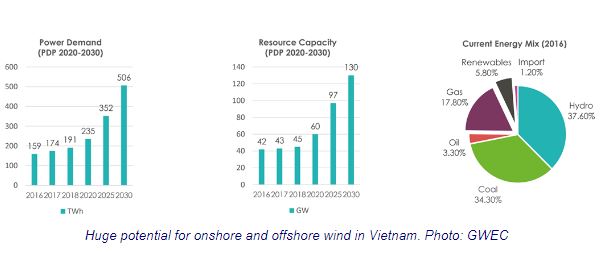Why is wind energy more cost-competitive in Vietnam?
Vietnam has become, in the eyes of investors, a destination for wind power developers for three reasons, according to the Global Wind Energy Council (GWEC).First, levelized cost of energy (LCOE), which is considered as the payback for energy systems, for onshore wind came down by 30% in the past four years.Second, wind energy with the deployment of large-scale capacity will timely meet the rising energy demand driven by rising population, GDP growth, and rapid urbanization.
Third, investment in new wind energy will be cheaper than investment in new coal by 2021 as costs of wind energy will continue to decrease, according to London-based not-for-profit think tank Carbon Tracker.
Accordingly, if Vietnam continues to invest in coal-fired power, the government needs to heavily subsidize coal in order to prevent rising cost of coal from impacting consumer prices while the country is reliant on coal imports. The Institute for Energy Economics and Financial Analysis (IEEFA) estimates that Vietnam spends US$1.3 billion each year on coal imports.

Wind power map in Vietnam. Photo: Daihochoasen
|
Downward trend
Under the prime minister’s Decision No.39/2018/QD-TTg dated September 10, 2018 on supporting wind power projects in Vietnam (the decision revised the one dated on June 29, 2011), the prices would be 8.5 US cents per kWh for onshore projects and 9.8 US cents for offshore projects.
The prices would be applied for partly or whole projects put into operations before November 1, 2021 and would last for 20 years.
The prices are not to mention other incentives like exemption of equipment import tariffs and corporate income taxes.
The International Renewable Energy Agency (IRENA) has released a report showing that costs from all commercially available renewable power generation technologies declined in 2018.
Accordingly, the global weighted-average cost of electricity declined 26% year-on-year for concentrated solar power (CSP), followed by bioenergy (-14%), solar photovoltaic (PV) and onshore wind (both -13%), hydropower (-12%), and geothermal and offshore wind (both -1%).
Foundations from world experts

Ben Backwell, CEO of GWEC. Photo: Chinawind
|
Ben Backwell, CEO of GWEC, said Vietnam is the country with one of the highest potential in Southeast Asia for both onshore and offshore wind as the country has 3,000-km coastline that results in the best resources for both. Vietnam is also the only country in the region that has developed offshore wind, with 99MW already installed.
GWEC’s Special Advisor Naveen Ballachandran told Hanoitimes that Vietnam is going to be the largest market in Southeast Asia for wind power and the market size gets bigger as potential remains untapped. Once the Vietnamese government tackles issues for further development of the industry, more opportunities will be visible for the investors.
Sharing the same idea, Vice President of Vestas Wind Systems A/S Morten Dyrholm said that the potential of wind power in Vietnam is huge and the situation will go upward for the case of Vietnam.
Meanwhile, Asia Director of GWEC Liming Qiao said that changes in policies are giving the industry renewed momentum and creating significant opportunities for the wind energy market to grow in Vietnam and the South East Asia region as a whole. In addition, the Vietnamese government is ready to make the shift to clean energy with a favorable Feed-in-Tariff policy mechanism – the selling prices of electricity from renewable energy sources sold to the grid or used on the spot – and ambitious renewable energy targets up to 2030.

GWEC’s Special Advisor Naveen Ballachandran. Photo: Evwind
|
Measures to improve cost competitiveness
GWEC has proposed modularization to keep production cost low for wind power in Vietnam. It covers product design component sourcing, manufacturing/assembly, transport/logistics, installation, and service and maintenance.
Cost reduction is expected from standardization of components and larger production volume for large components, reduced installations time, and reduced logistics and transportation cost.
Notably, digitalization is reckoned as a factor that helps revolutionize wind power. Indeed, technical applications and data analytics will help improve reliability and availability, better predictability of maintenance needs, and provide more data insights for better asset management across fleets.
As such, unlocking potential requires good performance, risk management, and high productivity, according to GWEC.


 Thailand
Thailand




